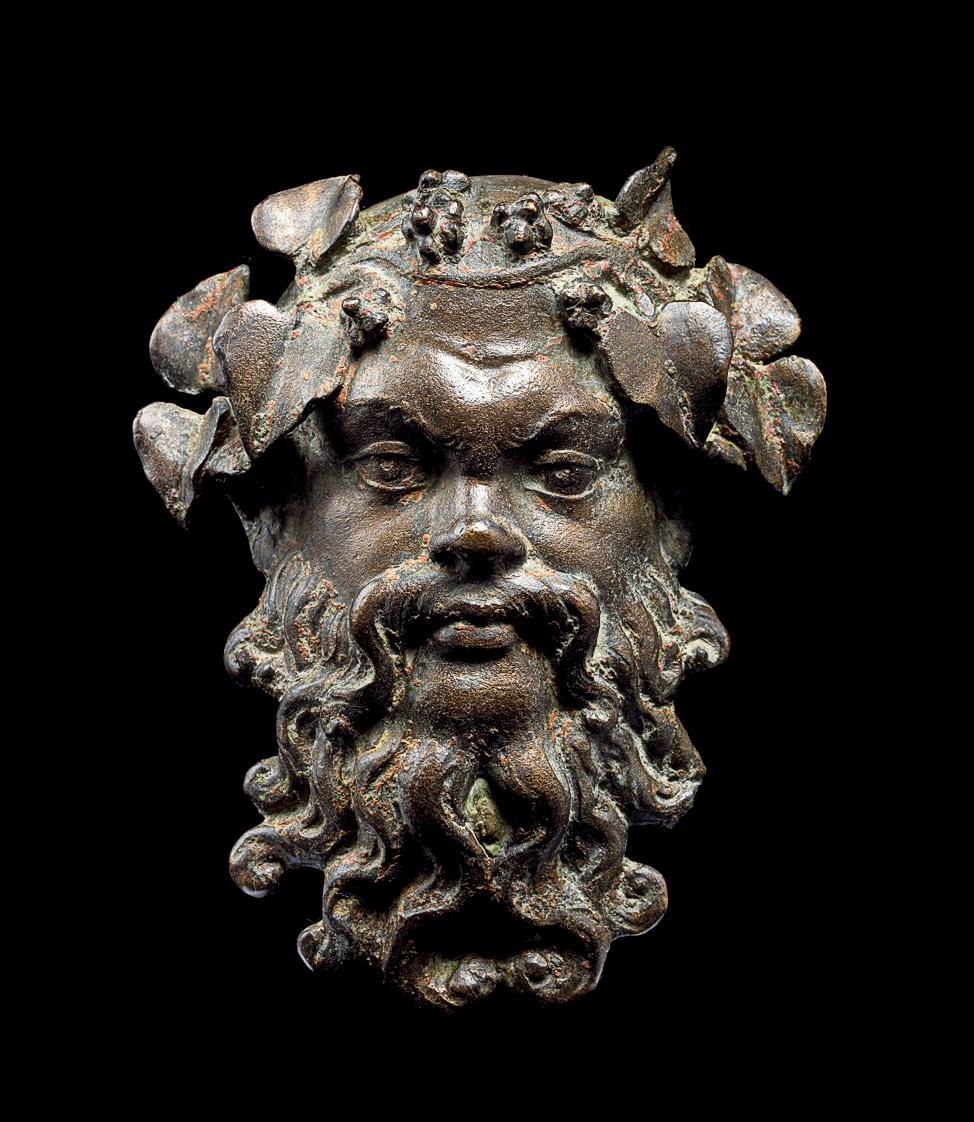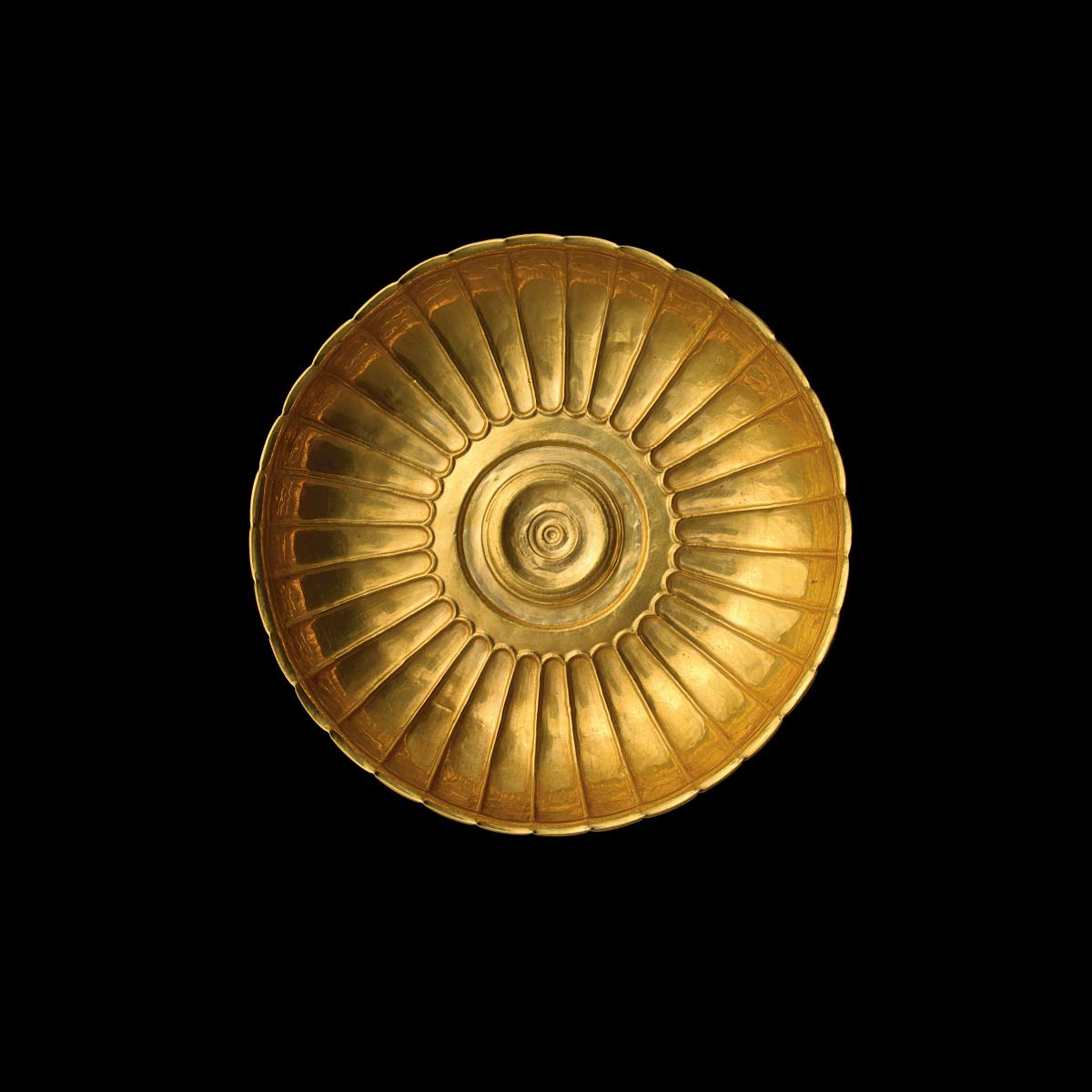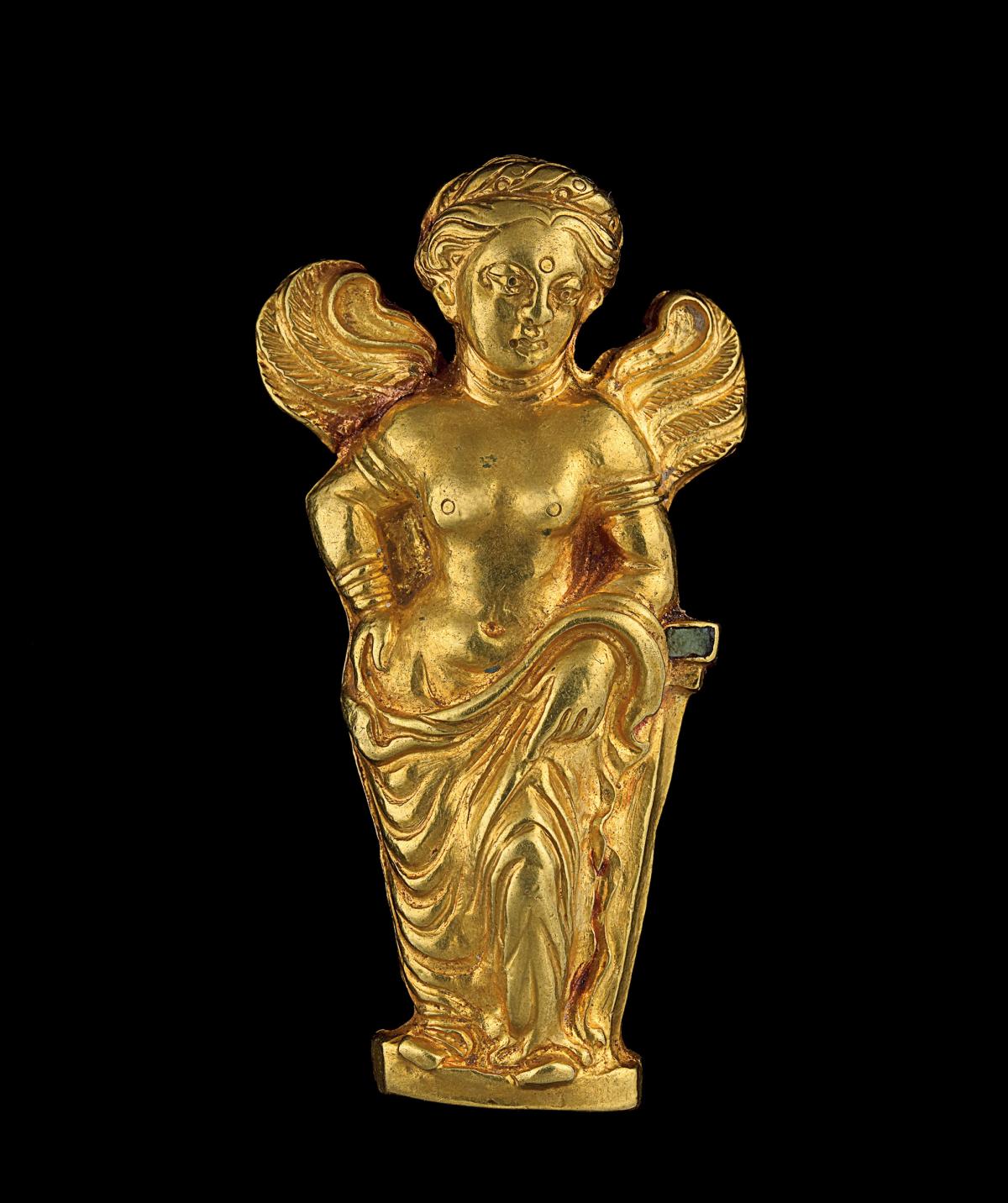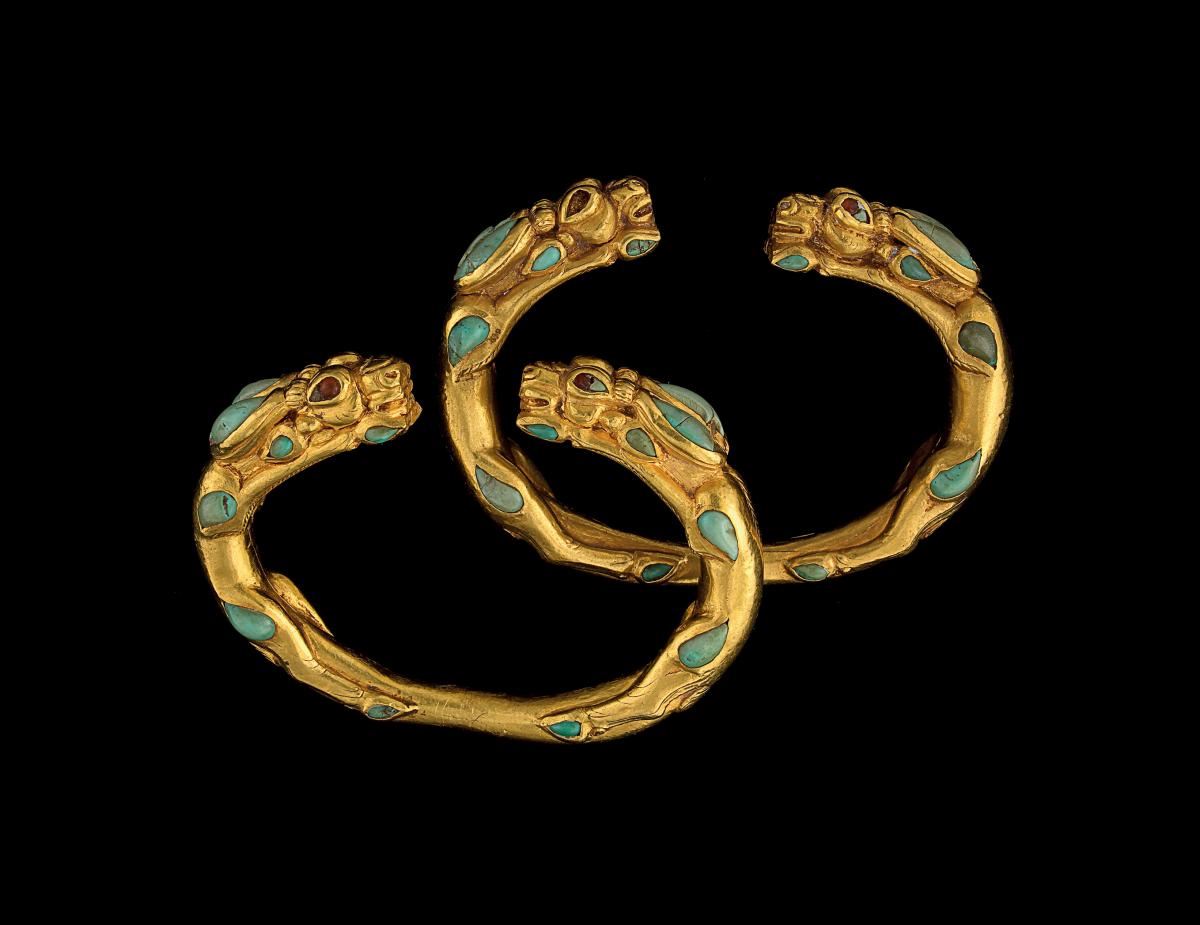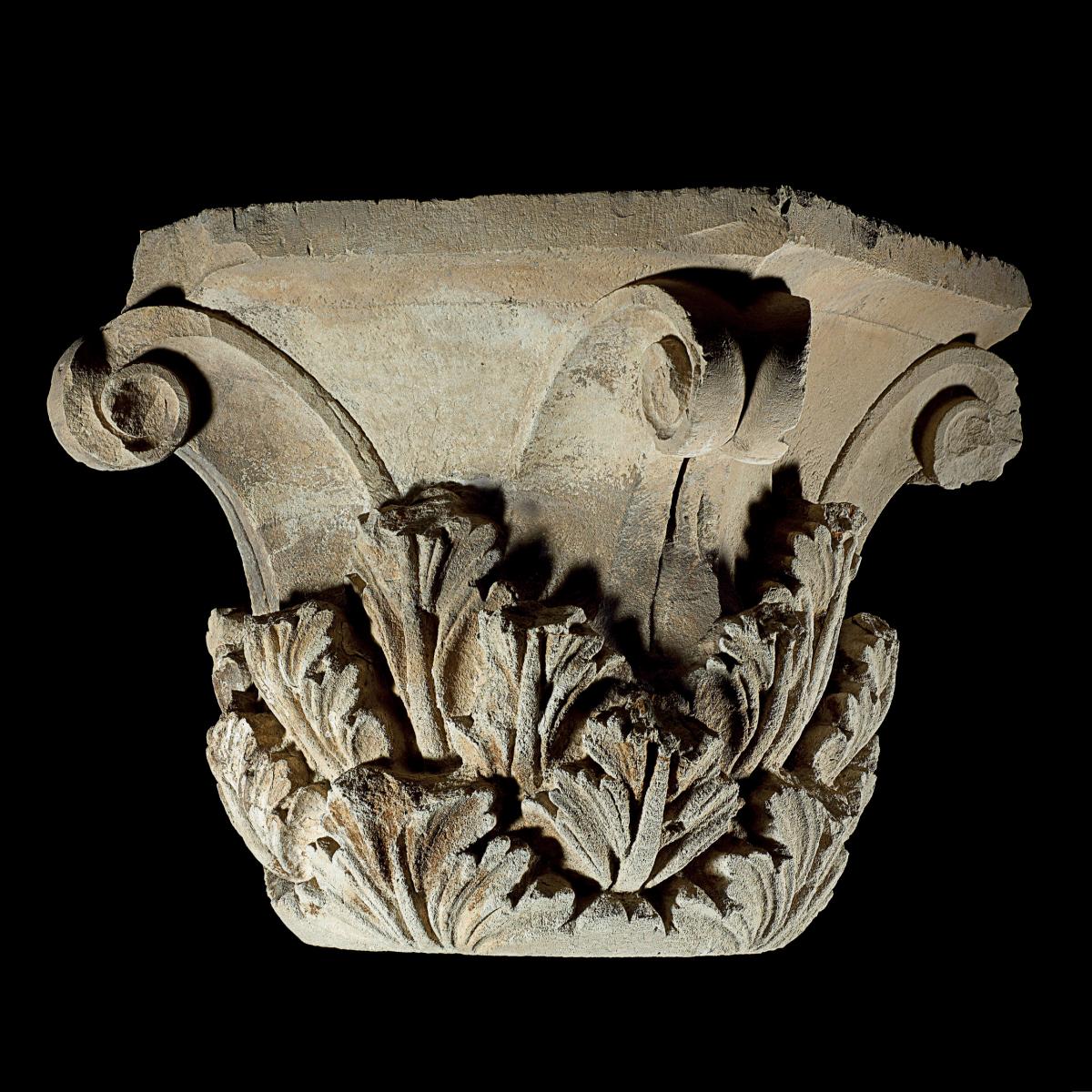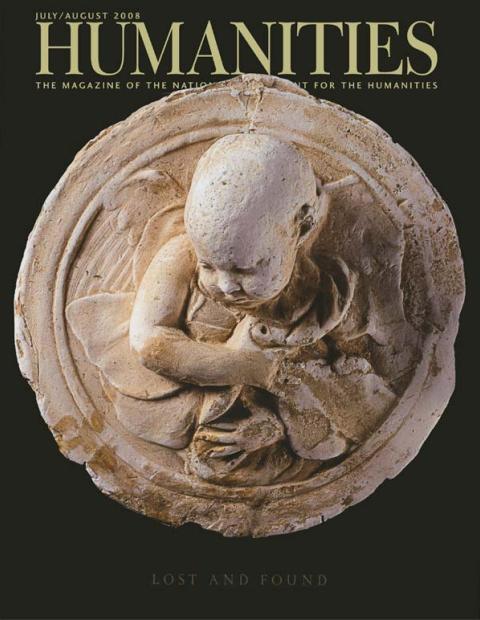Pick an object, any object, from the exhibition “Afghanistan: Hidden Treasures from the National Museum, Kabul.” A golden sheath for a nomad’s knife, a fish-shaped flask of Roman glass, a gilded silver platter found in a Greco-Bactrian temple—each is an exquisite hybrid of the religions, trade, and successive civilizations that layer Afghanistan. The timeline preceding these treasures is rich and varied, with cameo appearances from such luminaries as Zoroaster and Alexander the Great; however, time did not stop with their creation.
Situated between modern-day Pakistan and Iran, Afghanistan was the hub of the Silk Road trade routes, which stretched from China and India all the way to Italy. The routes were traveled intermittently from 300 B.C.E. to the beginning of the fifteenth century; these artifacts all date to the earliest travels, from about 300 B.C.E. to 200 C.E. Long before and after, however, cultures both at war and in commerce with each other buried artifacts many times over. The 228 pieces in this exhibition were unearthed in the twentieth century by archaeologists working at four northern sites; the earliest was inhabited around 2200 B.C.E. and the latest, first century C.E. Artistically significant and splendid, the objects were displayed in the National Museum in Kabul; unfortunately, Afghanistan’s buried treasures were no safer out of the ground than under it.
These products of overlapping interests nearly became casualties of them. Following a coup that toppled the Afghan government in 1978, three decades of foreign occupation, civil war, and religious zealotry pounded Afghanistan. Shelling gutted the National Museum in 1994, and looting and vandalism were thought to have scattered or destroyed the 100,000 objects once protected therein. In fact, much was lost. What saved these artifacts was a traditional museum practice that established a buddy system for its objects.
"Magnificent survivors"
“Hidden Treasures” is an apt title for this exhibition from the reconstructed and reopened National Museum: Every object now on display was tucked away for years. These magnificent survivors were spared from the Soviets, the mujahadeen, and the Taliban because their dedicated Afghan custodians had the foresight to hide them and the courage and discretion to keep the locations secret, risking their own lives to preserve their country’s cultural heritage.
“In our country,” says Abdul Karim Khurram, Afghanistan’s Minister for Information and Culture, “there might be very few places where historic artifacts can’t be found.” By 4000 B.C.E., settlers had long been farming the Hindu Kush foothills, fertile cropland that is also rich in gold, lapis lazuli, tin, copper, garnet, and carnelian. Early irrigation methods around 2000 B.C.E. made the desert plains of northern Afghanistan bloom and eased travel through central Asia.
The exhibition opens with golden bowls bearing evidence of the country’s native wealth and early trade. These artifacts were crafted from local gold around 2200 B.C.E. and discovered in 1966 by farmers at Tepe Fullol. Archaeologists named the Bronze Age culture that made them the Oxus civilization (after the region’s Oxus River, whose modern name is Amu Darya). Animals walking round the bowls include a boar and bearded bulls that hail from bordering Pakistan as well as distant Mesopotamia, more than a thousand miles away.
Fast forward to the first century C.E. and the far left bank of the Oxus River, where wealthy nomads established a cemetery in the ruins of a fire-worshippers’ temple near the oasis town of Sheberghan. In 1978, Viktor Sarianidi (born in Tashkent to Greek parents who raised him in Russia) and his Soviet-Afghan team excavated six tombs at Tillya Tepe, whose Uzbek name means “Hill of Gold.” Sarianidi discovered what has come to be known as the Bactrian Gold in situ: 20,578 objects interred with a warrior and five women, who may have followed their leader’s death with their own.
Nomads must carry their valuables on them, apparently even unto the grave, and pieces of gold in the thousands—jewelry, coins, buckles, and ornaments—adorned each of these well-to-do travelers head to foot. In fact, the warrior was found resting his head in a golden bowl, and one woman had gold soles beneath her feet. Hair ornaments abounded, and the skeleton of another young woman, perhaps a princess, was found wearing a shimmering crown whose peaks can be detached from the band, making it suitable for travel.
Nomads might be expected to have acquired their treasures in lands they journeyed through; instead, they acquired attributes from other lands and made their own treasures. As Sarianidi notes, “Here we have an original art style from the heart of the Silk Road.” One woman’s necklace has a figure-eight twist seen in Indian art and a cameo of a Greco-Bactrian soldier. The two-inch-high goddess of love known as the “Aphrodite of Bactria” packs an impressive array of influences. While she strikes the pose of the Greek Aphrodite, her voluptuousness and large, wide eyes may come from India, as does the bindi marking her forehead and the bracelets encircling her wrist and upper arms; her wings, an uncommon attribute for Aphrodite, look Near Eastern.
The Tepe Fullol bowls, the nomads interred within an earlier civilization’s ruins at Tillya Tepe, and the mix-and-match iconography displayed in the Bactrian Gold—even Sarianidi’s own heritage, which extends from Greece to Russia—are all threads that, woven together, create patterns repeated through Afghanistan’s tumultuous history. In 1979 another pattern, that of chaos and destruction, was unfortunately starting up, and Sarianidi left the country just before the Soviet invasion.
A new opening
When Fredrik Hiebert, then an archaeologist with the National Geographic Society, met Sarianidi in the deserts of Turkmenistan, they commiserated on the fate of the Bactrian Gold, which had been intermittently displayed before disappearing from sight. That was 1987, and in August 2003 Hiebert received a phone call telling him that Afghanistan’s president, Hamid Karzai, had opened the Central Bank vault in the presidential palace and found “a few boxes from the museum.” Afghan museum practice designates a tahilwidar, or key holder, responsible for locking particular objects into their cases, papering over the seal, and having witnesses sign the paper. Hiebert was asked to catalog the contents of the still-sealed boxes and, if the objects and their condition were as hoped, organize an international traveling exhibition.
Hiebert and Sarianidi reunited in that vault, where they were joined by the few tahilwidars still alive and in the country, Afghan officials, and an inventory team. Ultimately, cracking the safes required circular saws and permission from President Karzai—but here was the intact Bactrian Gold, in the plastic bags Sarianidi had used twenty-five years earlier. Museum officials and key holders had reused the bags to pack up the collection and bury it in the vault. Additional trunks yielded almost every object on museum display before 1990, and these protected artifacts heartened the inventory team when it took to the museum storerooms and witnessed the manuscripts slashed and statues smashed by the Taliban, who objected to all figurative art.
While Afghanistan is a relatively new nation—a committee fashioned its borders in the late nineteenth century—the regions bound together include some of the world’s oldest cultures. By 2000 B.C.E. , when the manmade oases flourishing in northern Afghanistan attracted invaders as well as traders, there rose up fortified towns with urban centers. During that era, the renowned city of Balkh became Bactria’s capital city. Described in antiquity as “the mother of all cities,” Balkh was the birthplace of the ancient poet and religious prophet Zoroaster, who may be buried there.
It was Cyrus the Great of Persia who named this area “Bactria” around 530 B.C.E. Darius ruled there shortly thereafter, and Alexander the Great came through around 328 B.C.E.on his way to India. In Balkh, Alexander took Darius III’s daughter as his bride.
Thus, Bactria became an outpost of Greek culture. Aï Khanum, meaning “Lady Moon,” was established by one of Alexander’s commanders, Seleucus, in 300 B.C.E. and unearthed by French archaeologists in 1964, the first evidence of an ancient Greco-Bactrian city. The city flourished until 145 B.C.E., when it was brought down by Eurasian nomads, possibly a tribe related to the nomads buried at Tillya Tepe.
Aï Khanum’s artifacts tell much about daily life. Fragments of earthenware bowls bear inscriptions describing ancient contents such as olive oil, which was essential to the Greeks and had to be imported as Bactrian winters were too harsh for olive trees. City dwellers told time with sundials like the large hemispherical one that sits upon two lion legs.
Here, a distinct Greco-Bactrian style emerged, shown in full on a plaque portraying Cybele and a winged Nike, Greek goddesses of nature and victory, both in Greek garb. Their tall chariot is typical of Persian art, as is the stepped altar and the priest’s conical headdress and parasol, while the lions seem to have walked in from Asia Minor. Above them all shines the golden sun, depicted as the Greek god Helios, a crescent moon, long a Persian and Asia Minor symbol, and a starburst similar to ones from both Greece and Asia Minor.
The city of Balkh endured the demise of Bactria’s Greco-Roman cities and more, incorporating later cultures into its own, but it could not withstand the armies of Genghis Khan, who destroyed the city in 1220. A few years later, Genghis Khan killed all the inhabitants of Bamiyan, one of the southernmost cities in Bactria and famed site of the Bamiyan Buddhas, 1,500-year-old carved statues that stood 125 and 175 feet tall before the Taliban dynamited them in 2001.
Nomads favor compact treasures. This explains the generally small size of objects in the exhibition, which repeatedly illustrates how one artistic culture incorporated another, or two, or three. Because Silk Road merchants traveled from Europe to Asia and back under daunting conditions, portable luxury items also comprised their stock in trade, and among them were objects of mixed parentage. Artifacts unearthed from a storehouse in Begram, at the confluence of the Silk Road routes, include singular examples of this synthesis.
What additionally distinguishes these pieces is that they were created in towns all along the trade routes—outstanding pieces in diverse media—and brought to Begram. Roman plasters, Indian ivory, Roman and Egyptian glass, bronzes with Greek, Roman, and Egyptian features—French archaeologists in the 1930s discovered them all stashed together in two rooms. Perhaps a royal storehouse or a merchant’s stockrooms, these adjacent chambers may have been sealed off as early as second century C.E.
After stops in Washington, San Francisco, Houston, and New York, “Hidden Treasures” will return to the National Museum in Kabul. Built in 1922 and destroyed in 1994, the National Museum reopened in 2004. Posted outside is a white banner bearing the message “A nation stays alive when its culture stays alive.”* Until recently, it wasn’t clear that either would survive. Considering what the museum and nation have endured, the white banner could be seen as a flag of surrender, and yet this modest placard holds its ground in front of the rebuilt museum and serves as a testament to Afghanistan’s recovered cultural artifacts and the people who risked their lives safeguarding them.
* Copy has been altered since publication to reflect a correction or additional information.




